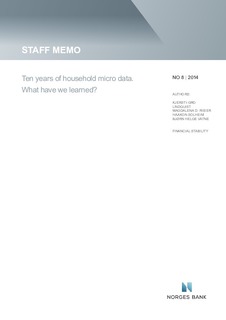| dc.contributor.author | Lindquist, Kjersti-Gro | |
| dc.contributor.author | Riiser, Magdalena D. | |
| dc.contributor.author | Solheim, Haakon | |
| dc.contributor.author | Vatne, Bjørn Helge | |
| dc.date.accessioned | 2018-07-31T07:47:28Z | |
| dc.date.available | 2018-07-31T07:47:28Z | |
| dc.date.issued | 2014 | |
| dc.identifier.isbn | 978-82-7553-811-4 | |
| dc.identifier.issn | 1504-2596 | |
| dc.identifier.uri | http://hdl.handle.net/11250/2506910 | |
| dc.description.abstract | Administrative register data for Norwegian households are used to analyse the distribution of debt and assets by income, wealth and age group. We find that the cross-sectional distribution is skewed. The distribution of debt across age has changed over time, with more of the debt being held by older households and less by younger ones. A birth-cohort study shows that households in later cohorts have more real debt than households in earlier cohorts when we compare the same life-cycle phase. Credit risk is evaluated using a number of measures and criteria. The overall conclusion is that the share of risky debt is small, but the share may increase significantly if interest rates climb to higher levels or house prices fall. | nb_NO |
| dc.language.iso | eng | nb_NO |
| dc.publisher | Norges Bank | nb_NO |
| dc.relation.ispartofseries | Staff Memo;8/2014 | |
| dc.rights | Attribution-NonCommercial-NoDerivatives 4.0 Internasjonal | * |
| dc.rights.uri | http://creativecommons.org/licenses/by-nc-nd/4.0/deed.no | * |
| dc.title | Ten Years of Household Micro Data. What Have We Learned? | nb_NO |
| dc.type | Working paper | nb_NO |
| dc.subject.nsi | VDP::Samfunnsvitenskap: 200::Økonomi: 210 | nb_NO |
| dc.source.pagenumber | 28 | nb_NO |

